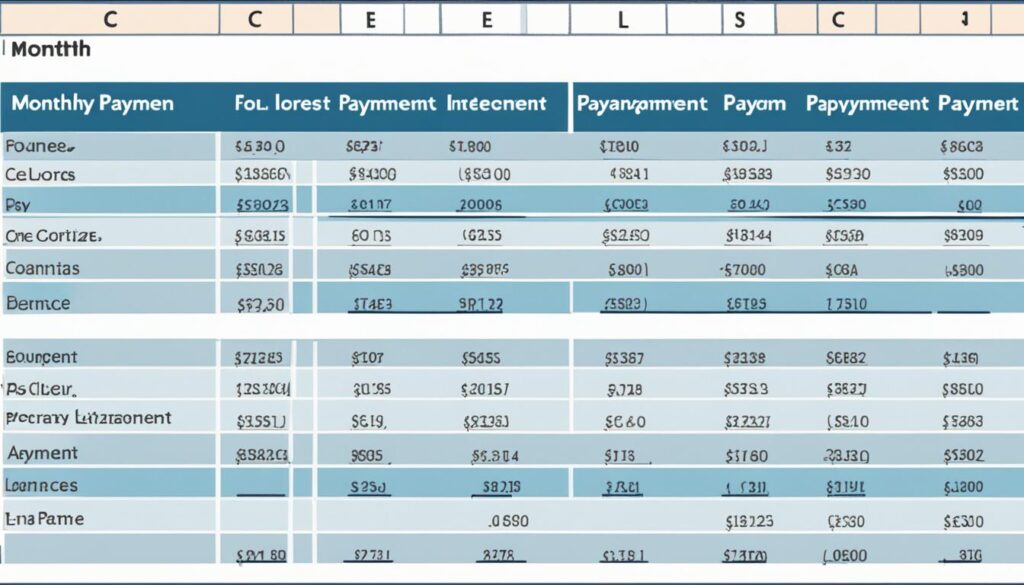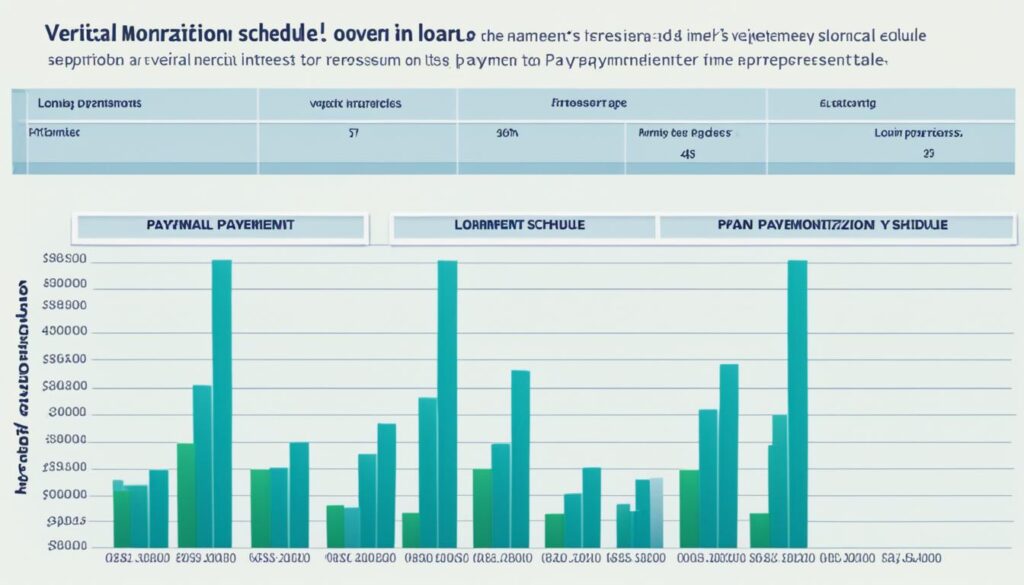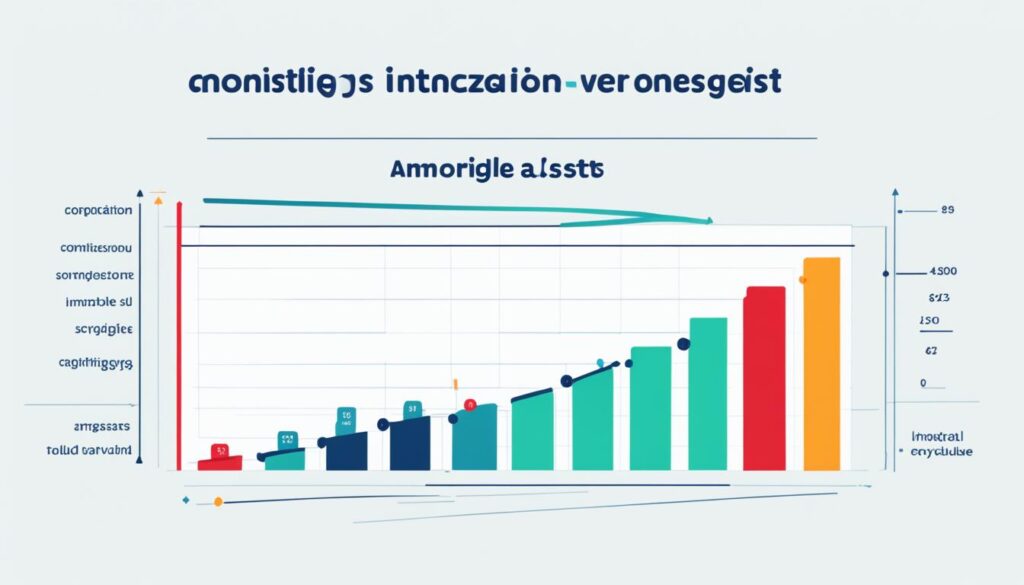A loan amortization schedule helps manage loan payments well. It explains how much of each payment goes to the loan balance, showing a decrease over time. This is very useful for big loans like mortgages or cars, or for smaller personal loans.
It makes it easier for borrowers to plan their money. They can see what part of their payment is for the loan’s main amount and what is for the interest.
Key Takeaways:
- A loan amortization schedule helps borrowers manage loan payments.
- It provides a breakdown of principal and interest payments over time.
- The schedule is useful for mortgages, auto loans, and personal loans.
- Understanding loan amortization helps borrowers budget their cash flows.
- It shows the portion of each payment that goes towards the principal and interest.
Understanding Amortization
Amortization is a way to lower the value of a loan or asset over time. It spreads out the loan payments, making them easier to handle. For intangible assets, it’s like depreciation, dividing the cost over the useful life.
It helps borrowers make steady payments on their loans. By not paying all at once, they can avoid big financial hits. This way, they steadily pay off what they owe.
Amortization lets borrowers plan their money better. They can see how much of each payment handles the loan’s amount and interest.
Things like patents and copyrights also get amortized. This matches costs with the money they make. It helps keep the asset’s value clear on a company’s books.
Let’s dive into how amortization works for loans and intangible assets:
Amortization of Loans
Loan amortization makes paying back money fair and doable. With each payment, the debt gets smaller and interest is paid off.
Payments at first pay mostly interest. Later, more goes to reducing the debt.
Here’s an example to help:
| Month | Payment | Principal | Interest | Remaining Balance |
|---|---|---|---|---|
| 1 | $500 | $250 | $250 | $9,750 |
| 2 | $500 | $260 | $240 | $9,490 |
| 3 | $500 | $270 | $230 | $9,220 |
The chart shows how loan payments work over time. It helps people understand how much goes to the loan and interest.

The image above shows a loan’s payment details. This makes it clearer how debt decreases as payments are made.
Knowing about loan amortization helps people manage their debts well. They can plan their finances and adapt how they pay back loans. This is key for financial health.
Loan Amortization Schedule
A loan amortization schedule shows how a loan is paid back over time. It is a table of loan payments, breaking down how much goes to principal and interest in each payment.
It helps you keep track of how you’re paying back your loan. You can see the balance go down over time as you make payments.
It can be adjusted to fit your loan term and financial needs. This way, it works better for you and your goals.
Lenders give this schedule with your loan papers. It makes the loan terms clear, so you know what you’re paying for and when.

From house loans to car payments, a schedule keeps you on track. It shows what your money is really going towards. This helps you make smarter choices with your money.
How to Calculate Loan Amortization
Calculating loan amortization lets you see how loans are repaid month by month. You find out the principal, total payment, and interest. There are many ways to do these calculations.
1. Financial Calculators:
Financial calculators are easy to use. They quickly show your payment schedule. Just enter the loan details to see your monthly payments.
2. Spreadsheet Software:
Spreadsheet software like Microsoft Excel does the math for you. It uses special formulas to break down payments into principal and interest.
3. Online Amortization Calculators:
Online calculators are also great. They’re on many finance sites. You can see your payment plan right away. Plus, they offer extra features and visuals.
To figure out the principal payment, you can use this simple formula:
Principal Payment = Total Payment – Interest Payment
Here’s what it means:
- Total Payment: What you pay monthly for both loan and interest.
- Interest Payment: Part of your payment that pays for interest.
This calculation helps you understand how much goes to your loan balance every month.
Learning loan amortization helps you with money choices. It’s key for mortgages, auto loans, or personal loans. Understanding your payments is vital for managing debt well and reaching financial goals.
Preparing Amortization Schedules
Amortization schedules help us understand and keep up with loan payments. They show the progress of paying back a loan. These schedules have six main columns.
- Period: The timing of each loan payment, usually every month.
- Beginning Loan Balance: The debt amount at the period’s start.
- Payment: Each month’s payment, covering interest and the loan amount.
- Interest: Part of the payment going to the loan’s interest.
- Principal: The part of the payment chipping away at the loan amount.
- Ending Loan Balance: The remaining debt after a payment.
Now, let’s dive into understanding each column better.
Period Beginning Loan Balance Payment Interest Principal Ending Loan Balance 1 $200,000 $1,342.05 $666.67 $675.38 $199,324.62 2 $199,324.62 $1,342.05 $665.27 $676.78 $198,647.84 3 $198,647.84 $1,342.05 $663.86 $678.19 $197,969.65 4 $197,969.65 $1,342.05 $662.44 $679.61 $197,289.04 5 $197,289.04 $1,342.05 $661.02 $681.03 $196,606.01
The Importance of Each Column
Period: This shows when each payment is due. It lets people follow how they’re paying off their loan over time.
Beginning Loan Balance: It tells the starting debt for each period. This helps calculate payments for interest and the loan itself.
Payment: This displays the total monthly payment needed. It covers both interest and the loan amount.
Interest: It shows the amount of each payment that’s for interest. This helps people see the total cost of borrowing.
Principal: It shows the part of the payment that lowers the loan balance. This way, people can track how much of the loan they’ve paid off.
Ending Loan Balance: This column reveals the remaining debt after a payment is made. It shows how the loan amount decreases over time.
Understanding the Schedule
Amortization schedules give a detailed view of loan payments. They help people manage their finances better. With these, you can see how much of each payment goes to interest and the loan, helping in budgeting and timely payments.
Pros and Cons of Loan Amortization
Loan amortization has its ups and downs. Knowing the good and bad helps people decide if it’s right for them. It’s all about making smart choices when it comes to paying off debts.
Pros of Loan Amortization
The best part about loan amortization is the steady payment pattern. Borrowers know what they owe each month. This makes it easier to track expenses and avoid sudden increases in payments.
It also means you pay off the loan bit by bit. As you make payments, you own more of what you bought. This ownership can help down the road, like when you sell or need a loan.
Amortized loans teach people to pay regularly. It builds good money habits and makes lenders see you as more reliable. Better trust from lenders can lead to better loan offers later on.
Cons of Loan Amortization
But loan amortization isn’t perfect. At first, you’re mainly paying interest, not the loan itself. So, it can feel slow to see your ownership grow.
Plus, because of the interest-heavy start, you might not build as much equity. This could be a problem if you plan to sell your home soon.
Also, you’ll pay more interest over time than with some other loans, like interest-only. Yet, there are big pluses too, like owning more of your property. And it helps you keep a steady payment schedule.
| Pros of Loan Amortization | Cons of Loan Amortization |
|---|---|
| Level payment structure for easy budgeting | Early payments primarily go towards interest, leading to slower equity buildup |
| Gradual reduction of loan’s principal balance | Principal balance decreases at a slower pace in the initial years |
| Establishes a disciplined repayment routine | Higher interest payments over the loan’s term |
When you look at the good and the bad, you need to think about your own goals. Deciding is all about finding the right balance and thinking ahead when paying back loans.

Amortization of Intangible Assets
Amortization is used for intangible assets like patents, copyrights, and trademarks. It spreads the cost of the asset over its useful life. This links the cost to the revenue the asset brings in. For tax purposes, it’s how businesses can take certain deductions.
The IRS sets out rules for how to amortize both tangible and intangible assets. This ensures the expense matches the asset’s worth correctly. Doing this means businesses follow clear guidelines on how to record these costs.
Amortization of Patents
The amortization of patents helps spread their cost over their life. This lessens the hit on a company’s finances at once. It shows that a patent’s value usually drops as time goes on, due to competition or new technology.
Imagine a company buys a patent for $500,000 that’s good for 10 years. When they spread this cost over time, it works out to $50,000 each year. This method follows the idea of linking costs to the use of the patent.
Amortization of Copyrights
Copyrights also get their cost spread out over their useful life. This is because their value decreases over time. It’s why companies amortize them, to accurately show their economic value.
Amortization of Trademarks
Trademarks have a limited useful life, similar to patents and copyrights. Companies spread their cost over this period. This practice helps in showing the true cost and handling accounting correctly.
| Intangible Asset | Useful Life |
|---|---|
| Patents | Typically 10-20 years |
| Copyrights | Between 50-70 years after the author’s death, or a fixed 95-year term for corporate-created works |
| Trademarks | No predetermined limit, as long as the owner remains vigilant in protecting and renewing the trademark |

Loan Amortization and Mortgage Payments
Understanding loan amortization is key for mortgage payments. It decides where your payment goes – to the loan amount or interest.
Each month, some of your payment shrinks the loan you took out. The rest covers interest, along with things like insurance and taxes.
As time goes on, more of your payment fights the loan interest instead. This change is good because it helps you own more of your home.
Earn equity means your home’s worth more than you owe. Paying the loan back builds this home value you own.
Knowing about loan amortization can guide your money choices. It teaches you how to grow equity and plan for your future.
The Benefits of Loan Amortization for Homeowners
Loan amortization offers homeowners several perks:
- Your fixed-rate mortgage makes budgeting easier. The payment stays the same.
- You build home equity as you pay less on the loan. It’s an asset you can use later.
- With lower loan amounts, interest costs drop, meaning you save money.
- Full mortgage payment frees up cash for other life goals, giving financial freedom.
“Loan amortization is key to owning your home and building wealth.”
The Importance of Regular Mortgage Payments
It’s crucial to pay your mortgage on time to build equity faster. Regular payments drop your loan amount steadily.
Extra payments help too. They cut the loan’s total cost and shorten how long you owe.
Understanding Your Loan Amortization Schedule
Your schedule breaks down each payment you make on your mortgage. It shows what goes to interest and what lowers your loan.
Here’s a sample loan amortization schedule:
| Payment Number | Payment Amount | Principal | Interest | Total Interest | Principal Balance |
|---|---|---|---|---|---|
| 1 | $1,200 | $200 | $1,000 | $1,000 | $199,800 |
| 2 | $1,200 | $205 | $995 | $1,995 | $199,595 |
| 3 | $1,200 | $210 | $990 | $2,985 | $199,385 |
This example shows how the principal part rises while interest falls. In the end, the loan gets fully paid.
Knowing about loan amortization helps in making smart homeownership decisions. From buying your first home to managing later ones, understanding loans is crucial. It paves the way for a smoother financial journey.
Conclusion
It’s essential to manage your loan payments well. A loan amortization schedule helps with this. It shows you the breakdown of what you pay in principal and interest over time.
With this schedule, you can plan your finances better. You’ll know how much of each payment goes to the principal and interest. This makes it easier to budget your money and manage loan payments.
A loan amortization schedule is key for any loan type. It helps you see how your debt reduces over time. Being organized and on top of your payments can help you reach financial stability.
FAQ
What is a loan amortization schedule?
A loan amortization schedule helps you pay your loan wisely. It shows how each payment reduces what you owe. This way, you can track your loan balance as it goes down.
How does amortization work?
Amortization lowers the value of a loan or asset over time. For loans, it means dividing payments over the loan term. It’s like how we spread the cost of an asset over its useful life.
What does a loan amortization schedule include?
It shows all your payments and what they’re for. You’ll see how much goes to the loan itself and to interest. This helps you understand the total cost and pay off the loan better.
How can I calculate loan amortization?
You can use a financial calculator or a spreadsheet. Also, there are online tools for this. The key formula is: principal payment = total payment – interest payment.
What information is included in an amortization schedule?
An amortization schedule has key details in columns. You’ll find the period, balance start, payment parts, and new balance. It details when you pay, your initial debt, and how it decreases with each payment.
What are the pros and cons of loan amortization?
Amortized loans have level payments, making budgeting easier. They decrease the principal over time. Yet, early payments mainly cover interest, slowing equity growth. This can be bad if you plan to sell soon.
What is the amortization of intangible assets?
It includes costs for items like patents or trademarks. The goal is to match asset expenses with revenue. Businesses spread out these costs over the asset’s useful life.
How does loan amortization affect mortgage payments?
It’s pivotal for managing mortgage payments. Initially, more goes to interest. But over time, more pays down the balance. This shift helps you own more of your home.
How can a loan amortization schedule help me manage loan payments?
It breaks down each payment’s principal and interest parts. This knowledge helps you make wiser financial choices. It’s a useful aid in managing your debt.




















